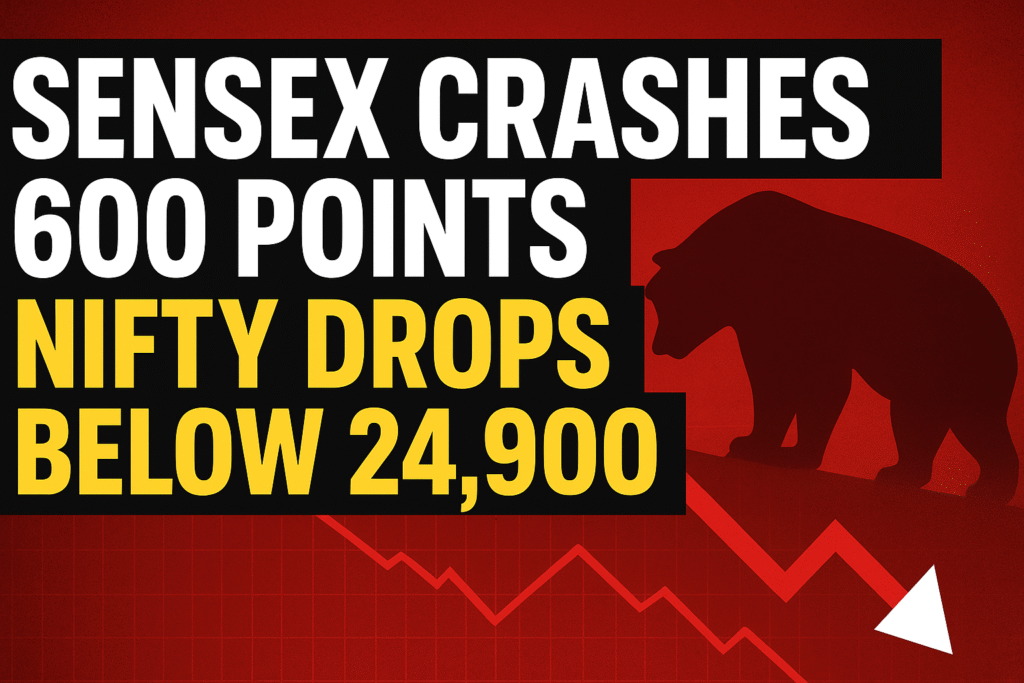Indian stock market crash: Indian stock markets witnessed a massive drop on Friday, August 22, 2025, as both Sensex and Nifty came under heavy selling pressure amid profit booking and global uncertainties.
The BSE Sensex fell nearly 700 points to hit a low of 81,313 in intraday trade, while the Nifty 50 index slipped below the crucial 24,900 mark to hit an intraday low of 24,869. Around 3 pm, the Sensex was down 614 points (0.75%) at 81,386, and the Nifty was trading 190 points (0.76%) lower at 24,893.
Interestingly, midcap and smallcap stocks showed relatively better resilience, with the BSE Midcap and Smallcap indices falling by only 0.5%.

So, what caused this sudden correction in the Indian stock market? Let us break it down into five key factors:
1. Profit Booking After 1,800-Point Rally in Sensex
After six consecutive sessions of gains, investors decided to book profits. The Sensex rallied nearly 1,800 points between August 13 and August 21, its longest upward streak since April 2025.
While the long-term outlook for the market remains bullish, short-term profit booking was expected. Analysts say tariff uncertainty and weak profitability have accelerated this downtrend.
2. Uncertainty over Trump’s tariffs on Indian goods
Global markets are anxiously watching US President Donald Trump’s tariff policy. A secondary tariff of 25% on Indian goods is set to come into effect from August 27, doubling the total tariff burden to 50%.
India has confirmed that exports worth about $50 billion will be directly affected. Analysts have warned that if these tariffs are implemented, it could have a worse impact on India’s growth outlook than previously estimated.
3. Caution ahead of Jerome Powell’s speech at Jackson Hole
Markets are also cautious ahead of US Federal Reserve Chairman Jerome Powell’s speech at the Jackson Hole symposium. This will be Powell’s last speech as Fed chairman and traders are hoping for cues about the future of US interest rates.
With global growth concerns already high, any hawkish stance or uncertainty from Powell could create volatility in markets around the world, including India.
4. Weak Q1 results, pressure on banking and IT stocks
The earnings season has not lived up to expectations. Weak Q1 results from major Indian companies have dented investor confidence.
Banking and IT—two key sectors in the indices—are under heavy selling pressure. Analysts believe the market will remain in a “sell on edge” trend until corporate earnings show a sustainable recovery.
5. Escalating Russia-Ukraine Tensions Fueling Crude Oil Rally
Geopolitical risks are also weighing on investor sentiment. Global crude oil prices have risen by over 1% on renewed tensions between Russia-Ukraine, a negative development for India, which is heavily dependent on oil imports.
Further, the US has indicated that any resolution of the dispute could impact tariff decisions on India. Until then, both geopolitical and economic uncertainties will keep markets under pressure.
Perspective: What should investors do?
Experts suggest that the current correction is a healthy correction rather than the beginning of a bearish trend. Volatility is expected to persist in the near term due to several global and domestic factors—such as Trump’s tariffs, Powell’s speech, and geopolitical concerns.
Long-term investors are advised to remain cautious, but not panic. Market corrections often present opportunities for fundamentally strong stocks, especially in midcaps and niche sectors.
